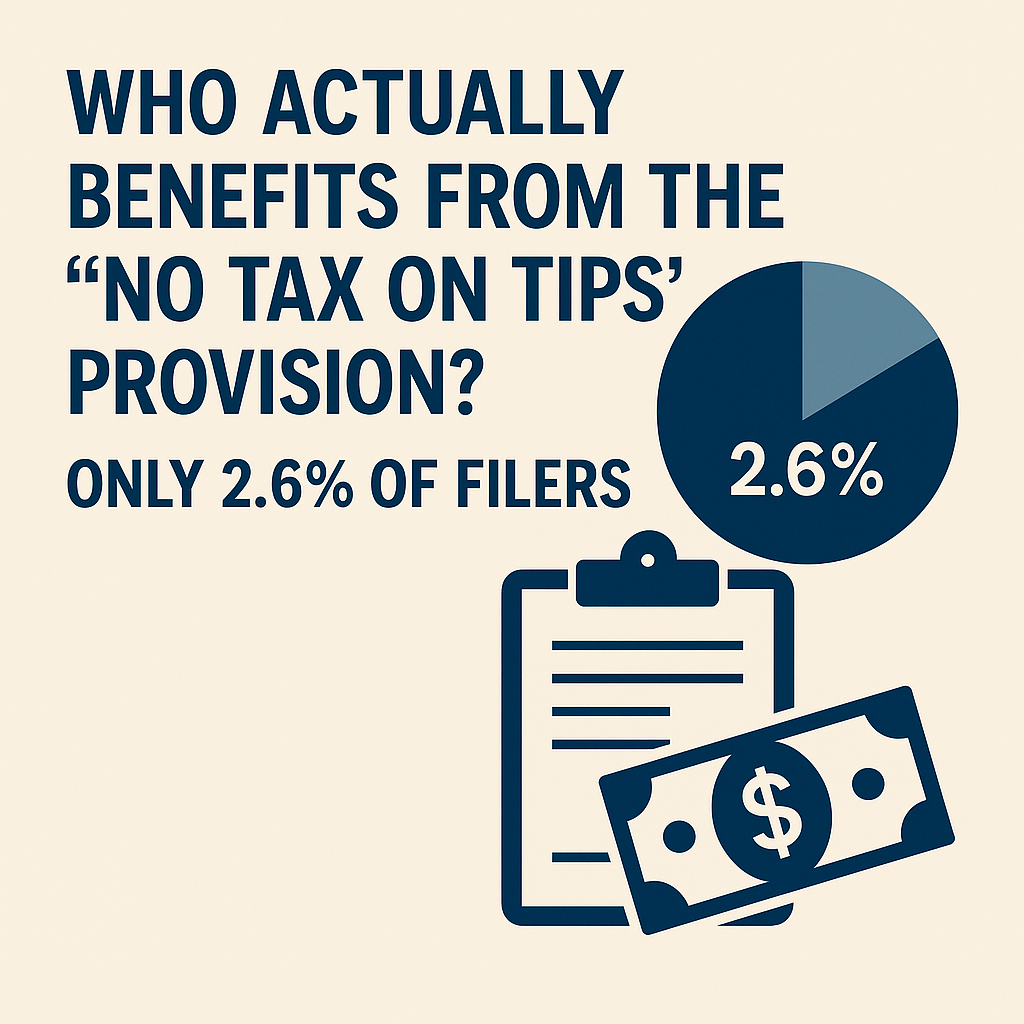
Only 2.6% of filers benefit from the No Tax on Tips rule, according to IRS data.
Who Actually Benefits from the “No Tax on Tips” Provision? Only 2.6% of Filers
The recently enacted No Tax on Tips provision made headlines as part of the 2025 tax reform package. At first glance, it sounds like a sweeping benefit for millions of tipped workers in restaurants, salons, rideshare services, and more. But in reality, the numbers tell a different story: according to IRS data and industry estimates, only about 2.6% of all federal income tax filers will qualify to use this new deduction.
How the No Tax on Tips Provision Works
Under the 2025 reform law, eligible taxpayers can deduct a portion of their tip income from taxable wages — effectively removing it from their federal income tax calculation. The idea is to put more take-home pay in the pockets of service industry workers who rely heavily on tips. However, the deduction is subject to strict conditions:
- It applies only to tips earned as part of a W-2 job where tips are reported to the employer.
- The benefit phases out for higher earners.
- Cash tips not reported to the employer still legally must be reported to the IRS, but won’t qualify for the deduction.
For a full overview of the legislative background and multi-year phase-in rules, see our earlier post No Tax on Tips Act 2025–2028: What Service Workers Need to Know.
Why Only 2.6% of Filers Benefit
According to IRS wage data, only a small fraction of taxpayers earn enough in reported tips to benefit meaningfully — and even fewer meet the income phase-in and phase-out rules. Many tipped workers have other sources of income that disqualify them, while others earn tips in cash-dominant sectors where reporting rates are historically low.
Key reasons for the narrow reach:
- Income limits: The deduction phases out entirely for individuals above a set AGI threshold, excluding higher-earning hospitality managers and seasoned professionals.
- Low reporting compliance: A significant share of tip income is not reported to employers, meaning it cannot be deducted under the No Tax on Tips law.
- Industry concentration: The majority of qualifying tipped workers are in full-service restaurants and bars, which represent a small portion of total U.S. employment.
What This Means for Service Industry Workers
For those who qualify under the No Tax on Tips deduction, the savings could range from modest to meaningful depending on tip volume and total taxable income. A full-time server earning $25,000 in wages and $10,000 in reported tips could see several hundred dollars in reduced tax liability. However, part-time workers or those with low reported tip amounts may see little change.
Who Doesn’t Benefit?
- Independent contractors in gig-economy roles like delivery or freelance hospitality — they are subject to self-employment tax and not covered by the W-2 tip rules.
- High-income professionals in industries where tipping occurs (such as luxury travel) but who exceed the AGI phase-out range.
- Workers in cash-heavy environments who underreport tips to employers — they do not qualify for the deduction.
IRS Reporting Still Required
The new law doesn’t change the IRS’s position: all tips are taxable income unless specifically excluded by statute. The No Tax on Tips provision is one such exclusion — but only for qualifying reported tips. See the IRS guidance on tip reporting here: IRS — Tip Recordkeeping and Reporting.
Bottom Line
The No Tax on Tips provision is a targeted benefit, not a universal one. While it may provide relief for a narrow slice of service industry workers, its overall reach is limited by strict eligibility criteria, income thresholds, and tip-reporting requirements.
The information provided in this blog post is for informational purposes only and should not be construed as legal, tax, or accounting advice. Tax situations are often complex and highly specific to the individual or business. You should contact a qualified tax expert directly to discuss your particular circumstances. Nothing herein is intended to, nor does it, create an attorney-client or advisor-client relationship.


